|
Week 3: August 15-21, 2009 |
Welcome
to the McGill Bird Observatory weekly report.
Click here for a complete listing of our archives.
Comments or
questions are welcome at "mbo AT migrationresearch.org".
|
PICTURE
OF THE WEEK: |
|
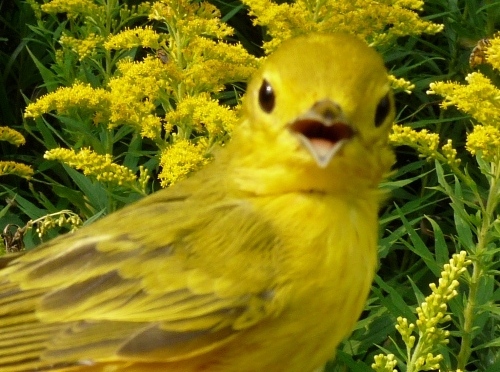
If we may be permitted a moment of anthropomorphism, it almost seems like this Yellow
Warbler is speaking up in protest against being photographed with a backdrop of
goldenrod, as if to say, "hey, I'm the yellow one!". But the reality is that while goldenrod
will be with us for most of the rest of fall, Yellow Warblers are one of the earliest migrants
to disappear from MBO, and already toward the end of week 3 we had days without any
observed, hard to believe given how dominant they remained last week.
(Photo by Marcel Gahbauer)

|
MBO
gratefully acknowledges the financial support
provided for the 2009 Fall Migration Monitoring
Program by TD Friends of the Environment Foundation
|
|
|
|
THIS WEEK |
THIS FALL |
2009 TOTAL |
SITE TOTAL |
|
# birds (and species) banded |
184 (33) |
560 (50) |
1564 (75) |
20485 (105) |
|
# birds (and species) repeat |
38 (16) |
102 (23) |
381 (40) |
3728 (66) |
|
# birds (and species) return |
3 (3) |
12 (10) |
130 (29) |
584 (35) |
|
# species observed |
83 |
99 |
152 |
198 |
|
# net hours |
544.0 |
1509.7 |
4868.2 |
35333.5 |
|
# birds banded / 100 net hours |
33.8 |
37.1 |
32.0 |
57.9 |
|
|
Note: table does not include nocturnal banding (owls) |
|
Banders-in-charge: Simon Duval, Marcel Gahbauer, Gay Gruner
Assistants: Christine Barrie, Gilles Burelle, Sophie Cauchon, Jean Demers, Barbara Frei, Tiffany Gilchrist, Marie-Anne Hudson, Helen Marchand, Francine Marcoux, Chris Murphy, André Pelletier, Clémence Soulard, Rodger Titman, Tegan Wahlgren, Roland Wahlgren
Notes: For those of us out at MBO this week, it seemed like a rather quiet week - and it was, with the number of birds banded only a bit higher than last week. But that's not unusual - in fact, week 3 has traditionally been the quietest week of fall, probably since early migrants have started to move out, boreal migrants are still relatively few, and we've already banded most of the local young by now. Despite how it felt, this was actually the most productive week 3 we've ever had in terms of birds banded!
Of course it is early enough in the season that even a relatively quiet week generates a number of first-of-season records. Newly observed for fall 2009 were another 13 species, in order of appearance: Double-crested Cormorant, American Woodcock, Yellow-bellied Flycatcher, Northern Harrier, Pileated Woodpecker, Blue-headed Vireo, Golden-crowned Kinglet, Philadelphia Vireo, Orange-crowned Warbler, Turkey Vulture, American Kestrel, Common Merganser, and Bay-breasted Warbler. Three species were banded for the first time this fall, bringing our count to 50 species already: Eastern Wood-Pewee, Yellow-bellied Flycatcher, and Hermit Thrush. Of note, the Eastern Wood-Pewee was also the first of its kind observed or banded at MBO this year, and we also missed banding Yellow-bellied Flycatcher on their northbound flight in spring.
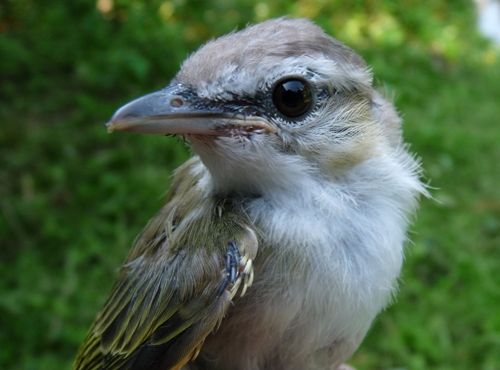
Although we're into the third week of "fall", there are still "babies galore", as was noted in our daily log at one point this week. Defining the start of fall as the beginning of August is necessary to get full coverage of some of the earlier migrants, but of course many local breeders still are going strong through all of what is summer here. The latest of those are Cedar Waxwings and American Goldfinches, some of them still incubating, but the very young Red-eyed Vireo above indicates that other species were still nesting into August as well.
(Photo by Marcel Gahbauer)
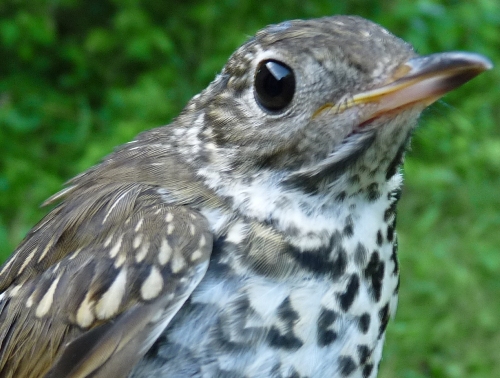
Yes, another juvenile! LIke the Brown Creeper and Yellow-rumped Warbler featured last week, this Hermit Thrush is noteworthy for showing up in our nets as a very young bird, despite us not being aware of the species nesting nearby.
(Photo by Marcel Gahbauer)
|
Song Sparrows maintained their position on top of the list of species banded for a third straight week. We keep thinking we must have banded all of them, then get back and find another half dozen or more in the nets the next day! Clearly, with 95 of them banded over the past three weeks, we're no longer dealing with just local birds! The past two years, American Redstart has topped the list in week 3; this year they fell short thanks to the abundance of Song Sparrows, but still showed a big increase over week 2 as usual. After two weeks as runner-up to the Song Sparrow, Yellow Warbler has faded to near the bottom of the list, and will probably not reappear there until some time next May. Jumping in to a tie for third place this week were two other warblers - Common Yellowthroat and Black-and-white Warbler. The other addition to the list this week was American Goldfinch, including the first of this year's young. The remaining species (Red-eyed Vireo, Gray Catbird, Traill's Flycatcher, and Rose-breasted Grosbeak) shuffled positions a bit from last week.
With respect to birds observed, there was only one new additions to the top ten this week, with Red-winged Blackbird displacing Canada Goose. The Black-capped Chickadees are likely still mostly local residents, but they were vocal and active enough this week to slide up into the top spot ahead of Cedar Waxwing (erratic, with larger flocks on a couple of days) and American Goldfinches (still singing plenty as for them it's still prime breeding season). Grackles dropped off a bit this week, but we're sure larger flocks will be returning later this fall.
This week’s top 10 [last week's rank in brackets]
# individuals banded |
mean # individuals observed daily |
1. Song Sparrow (37) [1] |
1. Black-capped Chickadee (17.0) [3] |
2. American Redstart (20) [5] |
2. Cedar Waxwing (15.9) [6] |
3. Common Yellowthroat (10) [-] |
3. American Goldfinch (15.7) [4] |
3. Black-and-white Warbler (10) [-] |
4. Red-winged Blackbird (12.4) [-] |
5. Red-eyed Vireo (9) [9] |
5. Song Sparrow (11.6) [5] |
5. Gray Catbird (9) [3] |
6. American Crow (11.3) [2] |
7. Traill's Flycatcher (8) [6] |
7.American Robin (8.1) [8] |
8. American Goldfinch (7) [-] |
8. House Wren (7.6) [9] |
8. Yellow Warbler (7) [2] |
9. Common Grackle (6.6) [1] |
8. Rose-breasted Grosbeak (7) [7] |
10. Gray Catbird (6.3) [9] |
|
We owe a BIG thank you to Malcolm Johnson, who came in this week to mow all of our net lanes - the ongoing heat and moisture has made it a jungle out there, and we were in sore need of taming it. Meanwhile, all of the BICs have also been taking turns trying to regain some control over the vegetation, especially along the net lanes and census trail. We take habitat photos annually, so that we can try to maintain relatively consistent conditions over the years (in order to minimize confounding effects with any trends we document in our bird data). Of course maintaining complete stasis in a largely successional habitat is impossible, but by selectively trimming some shrubs and trees and removing others, we're striving to achieve an overall balance. The same holds true for the census trail, where buckthorns and vines in particular have grown to obstruct some productive viewpoints - but there it's also a matter of just keeping the trail itself in decent shape so that censusers can concentrate on looking for birds rather than finding their footing and avoiding branches in the eyes! We've made some good progress on that, and hope to get all this site maintenance done before migration kicks into a higher gear in September!
|
In the "critter corner" this week we feature three of the most cute / interesting / peculiar non-birds at MBO this week (you get to pick which descriptor applies to which, according to your personal preferences!).
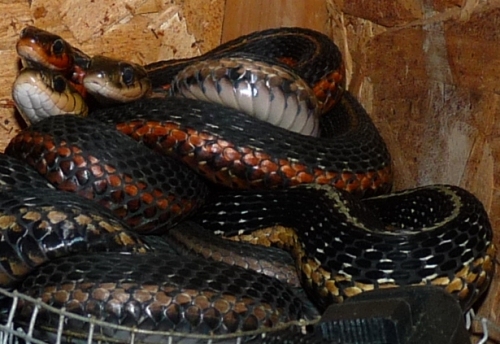
The shed attached to the banding cabin was long overdue for a good cleaning, and we took advantage of a couple of slower mornings this week to tackle it. Unfortunately, in doing so we disturbed this cozy trio of garter snakes, that had climbed up to coil together on top of a roll of wire. The good news is that while they slithered off in frustration at the commotion, they were all back the next day, enjoying our newly stacked pile of firewood. Note the distinctly different colouration of each of the three snakes.
(Photo by
Marcel Gahbauer)
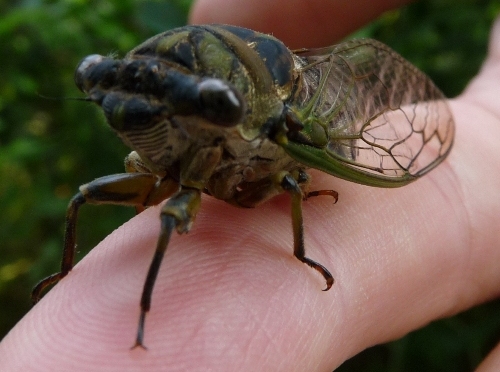
The persistent buzzing of cicadas is a common sound of summer in Montreal, as it is in many areas. However, while most are familiar with the sound, we're willing to bet relatively few have ever handled a cicada. This week several of us had that opportunity, courtesy of them flying into our nets. Fortunately, aside from some annoyed buzzing, they were actually quite well-behaved, and they're certainly quite a beast to look at up close.
(Photo by Marcel Gahbauer)
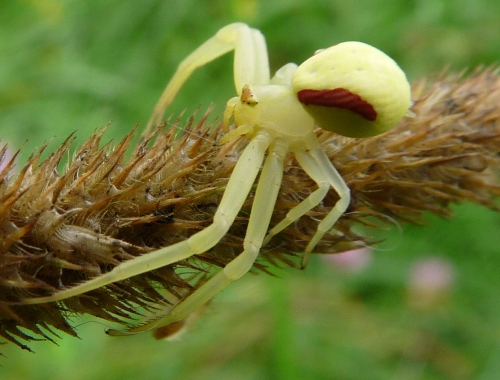
A colourful discovery on the last morning of the week, this small Goldenrod Crab Spider (Misumena vatia) was right along the path from the 'parking circle' to the banding cabin. Not only are the colours striking, but the body shape (dimples on the back barely visible from this angle, and the oversized front legs) is quite unusual.
(Photo by Marcel Gahbauer)
|







